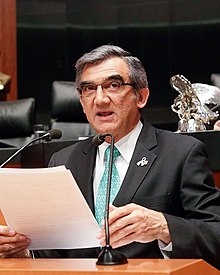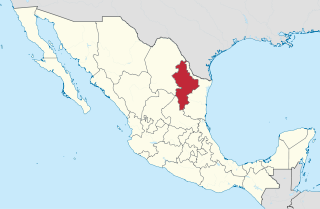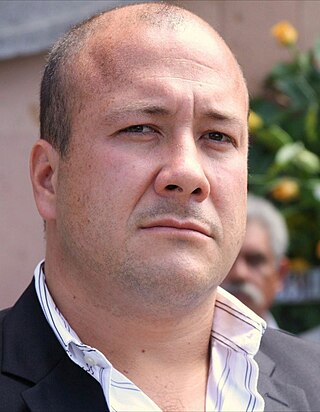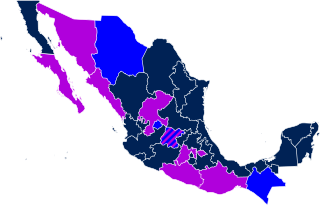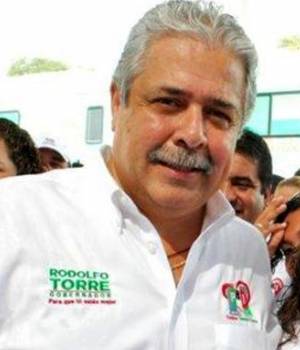| Name | Term |
| Don Pedro José de Lanuza | September 26, 1822 – November 28, 1822 |
| Juan de Echeandía | November 28, 1822 – April 13, 1823 |
| José Antonio Flores | April 21, 1823 – May 17, 1823 |
| Jose Manuel Zozaya | May 17, 1823 – September 8, 1823 |
| José Lino Perea | September 8, 1823 – September 23, 1823 |
| Juan Francisco Gutierrez | September 23, 1823 – October 20, 1823 |
| José Lino Perea | October 20, 1823 – October 28, 1823 |
| Juan Francisco Gutierrez | October 28, 1823 – April 9, 1824 |
| José Lino Perea | April 9, 1824 – April 18, 1824 |
| Juan Francisco Gutierrez | April 18, 1824 – July 18, 1824 |
| José Bernardo Maximiliano Gutiérrez de Lara | July 19, 1824 – July 28, 1824 |
| Enrique Camilo Suarez | July 28, 1824 – October 2, 1824 |
| José Bernardo Maximiliano Gutiérrez de Lara | October 2, 1824 – March 4, 1825 |
| Enrique Camilo Suarez | March 4, 1825 – January 15, 1826 |
| Lucas Fernandez | January 15, 1826 – June 10, 1828 |
| Enrique Camilo Suarez | June 10, 1828 – October 1, 1828 |
| Lucas Fernandez | October 1, 1828 – October 1, 1829 |
| José Antonio Fernández Izaguirre | October 1, 1829 – December 27, 1829 |
| Francisco Vital Fernandez | December 27, 1829 – January 13, 1830 |
| Enrique Camilo Suarez | January 13, 1830 – February 18, 1830 |
| Jose Manuel Zozaya | February 18, 1830 – April 5, 1830 |
| Enrique Camilo Suarez | April 5, 1830 – April 20, 1830 |
| Jose Manuel Zozaya | April 20, 1830 – July 7, 1830 |
| Juan Guerra | July 7, 1830 – August 20, 1831 |
| Francisco Vital Fernandez | August 20, 1831 – March 19, 1832 |
| Jose Honorato de la Garza | March 19, 1832 – August 7, 1832 |
| General Francisco Vital Fernandez | August 7, 1832 – March 1, 1833 |
| Juan Nepomuceno Molano | March 1, 1833 – September 4, 1833 |
| Francisco Vital Fernandez | September 4, 1833 – July 16, 1834 |
| Ramon Cardenas | July 16, 1834 – September 17, 1834 |
| Francisco Vital Fernandez | September 17, 1834 – March 20, 1835 |
| José Guadalupe de Samano | March 20, 1835 – April 25, 1835 |
| Francisco Vital Fernandez | April 25, 1835 – September 15, 1835 |
| José Antonio Fernández Izaguirre | September 15, 1835 – August 1, 1836 |
| José Guadalupe de Samano | August 1, 1836 – September 15, 1836 |
| José Antonio Fernández Izaguirre | September 15, 1836 – May 29, 1837 |
| Jose Antonio Quintero | May 29, 1837 – December 11, 1838 |
| José Antonio Fernández Izaguirre | December 11, 1838 – March 24, 1839 |
| Jose Antonio Quintero | March 24, 1839 – June 23, 1841 |
| Jose Antonio Salazar y Boeta | June 23, 1841 – September 19, 1841 |
| General Francisco Vital Fernandez | September 19, 1841 – June 9, 1843 |
| Jose Ignacio Gutierrez | June 9, 1843 – July 10, 1843 |
| Juan Nepomuceno Cortina | July 10, 1843 – August 21, 1843 |
| Jose Ignacio Gutierrez | August 21, 1843 – December 18, 1844 |
| Juan Nepomuceno Cortina | December 18, 1844 – January 18, 1845 |
| Manuel de Saldaña | January 18, 1845 – February 4, 1845 |
| Pedro José de la Garza | February 4, 1845 – July 21, 1845 |
| Victorino T. Canales | July 21, 1845 – November 23, 1845 |
| Juan Martin de la Garza Flores | November 23, 1845 – October 19, 1846 |
| Manuel Núñez Ponce | August 28, 1846-did not take possession |
| Manuel Saldaña | October 19, 1846 – November 10, 1846 |
| Francisco Vital Fernandez | November 10, 1846 – September 18, 1848 |
| Eleno de Vargas | July 26, 1847 – August 16, 1847 |
| Jesús de Cárdenas | September 18, 1848 – August 17, 1851 |
| Antonio Canales Rosillo | August 17, 1851 – September 30, 1851 |
| Jesús de Cárdenas | September 30, 1851 – November 19, 1852 |
| Juan José de la Garza Cisneros | November 19, 1852 – December 21, 1852 |
| Ramon Prieto | December 21, 1852 – January 13, 1853 |
| Rafael Chovel | January 13, 1853 – March 20, 1853 |
| Juan Francisco Villasana | March 20, 1853 – May 2, 1853 |
| Adrian Woll | May 2, 1853 – January 28, 1855 |
| Romulo Diaz de la Vega | January 28, 1855 – April 4, 1855 |
| Adrian Woll | April 4, 1855 – September 8, 1855 |
| Juan José de la Garza Cisneros | September 30, 1855 – May 9, 1856 |
| Ramon Guerra | May 9, 1856 – August 9, 1856 |
| José de la Garza Cisneros | August 9, 1856 – February 19, 1857 |
| Tomás Moreno | February 19, 1857 – August 1, 1857 |
| Andrés José de Cos | August 1, 1857 – August 27, 1857 |
| Juan Fernández Flores | August 27, 1857 – October 19, 1857 |
| Juan José de la Garza Cisneros | October 19, 1857 – January 7, 1858 |
| Ramón Guerra | January 7, 1857 – January 17, 1858 |
| Juan José de la Garza Cisneros | January 17, 1858 – March 12, 1858 |
| Ramon Guerra | March 12, 1858 – July 30, 1858 |
| Juan José de la Garza Cisneros | July 30, 1858 – February 26, 1859 |
| Andrés Treviño | February 26, 1859 – January 13, 1860 |
| Juan José de la Garza | April 16, 1860 – August 1, 1861 |
| Manuel Saavedra | November 26, 1860 – February 9, 1861 |
| Modesto Ortíz | August 1, 1861 – September 1, 1861 |
| Jesús de la Serna | September 1, 1861 – January 30, 1862 |
| Ignacio Comonfort | January 30, 1862 – August 9, 1862 |
| Albino López | August 9, 1862 – September 15, 1862 |
| Juan B. Troconis | September 15, 1862 – October 23, 1862 |
| Albino López | October 23, 1862 – August 1, 1863 |
| Manuel Ruíz | August 1, 1863 – November 5, 1863 |
| Jesús de la Serna | November 5, 1863 – January 1, 1864 |
| Manuel Ruíz | January 1, 1864 – January 12, 1864 |
| Juan Nepomuceno Cortina | January 12, 1864 – September 26, 1864 |
| Jose Maria Carvajal | September 26, 1864 – April 15, 1865 |
| Francisco de León | April 1865-December 1865 |
| Juan Nepomuceno Cortina | March 1865-late 1866 |
| Jose Maria Carvajal | March 4, 1866 – August 20, 1866 |
| Servando Canales Molano | August 20, 1866 – August 31, 1866 |
| Santiago Tapia | August 31, 1866 – November 3, 1866 |
| Felipe Berriozábal (Northern District) | September 30, 1866 – September 1, 1867 |
| Ascensión Gómez (Central District) | September 30, 1866-March 1867 |
| Francisco de León (Central District) | March 6, 1867 – June 27, 1867 |
| Felipe Escandón (Central District) | June 27, 1867 – July 5, 1867 |
| Juan de Haro | September 30, 1866 – April 3, 1867 |
| Desiderio Pavón | August 14, 1867 – April 16, 1868 |
| Francisco L. Saldaña | April 16, 1868 – July 31, 1868 |
| Juan José de la Garza Cisneros | August 1, 1868 – December 1, 1869 |
| Francisco L. Saldaña | December 1, 1869 – August 30, 1870 |
| Servando Canales Molano | September 1, 1870 – June 1, 1872 |
| Ramón Guerra | June 1, 1872 – August 5, 1872 |
| Servando Canales Molano | August 5, 1872 – September 10, 1874 |
| Francisco Echartea | September 10, 1874 – June 1, 1875 |
| Servando Canales Molano | June 1, 1875 – September 6, 1875 |
| Francisco Echartea | September 25, 1875 – April 20, 1876 |
| Servando Canales Molano | April 20, 1876 – November 6, 1876 |
| José Martínez | October 17, 1865 – October 28, 1876 |
| Gómez Ascensión Mansilla | November 6, 1876 – January 13, 1877 |
| Juan Gojón | January 13, 1877 – February 6, 1877 |
| Francisco Echartea | February 6, 1877 – November 22, 1877 |
| Juan Gójon | November 22, 1877 – October 16, 1878 |
| Francisco Echartea | October 16, 1878 – April 10, 1879 |
| Juan Gójon | April 11, 1879 – May 12, 1880 |
| Antonio Canales Molano | May 12, 1880 – May 3, 1884 |
| Juan Gójon | January 18, 1884 – March 12, 1884 |
| Romulo Cuellar | May 4, 1884 – May 3, 1888 |
| Alejandro Prieto Quintero | May 4, 1888 – May 3, 1896 |
| José Guadalupe Mainero Juárez | May 4, 1896 – July 31, 1901 |
| Alejandro Prieto Quintero | July 31, 1901 – August 10, 1901 |
| Matías Guerra | August 10, 1901 – September 30, 1901 |
| Pedro Argüelles | October 1, 1901 – March 3, 1908 |
| Juan B. Castelló | March 4, 1908 – June 1, 1911 |
| Espiridión Espiridión | June 1, 1911 – November 30, 1911 |
| Matías Guerra | November 30, 1911 – February 4, 1912 |
| Joaquin Argüelles | February 5, 1912 – May 5, 1912 |
| Matías Guerra | May 5, 1912 – January 12, 1913 |
| José C. Mainero | January 12, 1913 – January 30, 1913 |
| Joaquín Argüelles | June 28, 1913 – July 24, 1913 |
| Antonio Rabago | July 24, 1913 – November 18, 1913 |
| Ignacio Zaragoza Morelos | November 19, 1913 – May 14, 1914 |
| Luis Caballero Vargas | November 18, 1913 – July 26, 1916 |
| Gonzalo Castro | October 15, 1914 – October 20, 1914 |
| Máximo García | April 16, 1915 – June 9, 1915 |
| Raúl Garate Legleú | October 7, 1915 – November 24, 1915 |
| Raúl Garate Legleú | March 1916-June 1916 |
| Flores Trejo Fidencio | July 26, 1916 – February 22, 1917 |

